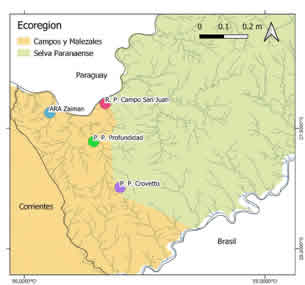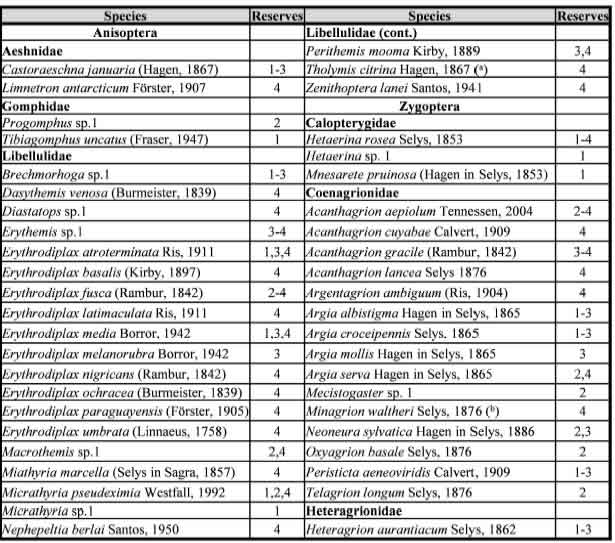INTRODUCTION
Campos y Malezales ecoregion comprises an approximate area of 26,000 km. in the southern portion of Misiones and north of Corrientes provinces, in NE Argentina. The landscape in this ecoregion is dominated by pastures and grasslands with isolated patches of forests and a dense canopy forest bordering the fluvial courses. This area represents an ecological transition among the limiting ecoregions: Selva Paranaense to the northeast, Esteros del Iberá and Espinal to the southwest (), which favors the presence of a rich fauna including several regional threatened species and a great floristic diversity (). Despite this, it is the least protected region of the country (Chebez, 2005) and at the same time, one of the most threatened due to its small area, increasing agriculture, forestation with exotic species, and growing urbanization.
According to the latest checklist, 282 species of odonates are known to be present in Argentina, of which 195 have been cited in Misiones, a highly diverseprovince (). However, these valúes are higher on the region enclosed in the Selva Paranaense ecoregion (represented in Argentina only in Misiones province) where 170 species have been recorded, while Campos y Malezales ecoregion (represented in Argentina in Corrientes and Misiones province), presents 94 species (). The unequal distribution of species may be in part due to the higher biodiversity of the Selva Paranaense, but also to a different sampling effort regarding Odonata in Misiones, with the majority of the surveys historically dedicated to the forested sector, leaving the area of Campos y Malezales underrepresented. This lack of knowledge contrasts with the fact that regional biodiversity inventories and species distribution records are important to support conservation strategies for species and their habitats (Renner et al., 2017).
The main goal of this work is to present the first checklist of Odonata diversity conducted in four reserves present in Campos y Malezales ecoregion, two of them including the ecotone with Selva Paranaense in Misiones province, provide new records and to contribute to the knowledge of the Odonata fauna of the region for future conservation studies.
MATERIAL AND METHODS
Study area
The study was carried out in streams of four reserves, located in the southern range of the Misiones province (Campos y Malezales ecoregion) (Fig. 1, Table I). The climate is subtropical humid, with uniform rainfall throughout the year, between 1,500-1,700 mm annual and average temperature ranging 20 - 22 °C ( ;). This study was centered on lotic environments, the streams surveyed in these reserves belong to the Paraná basin. For the ecoregion scheme we followed.
RESULTS
Reserves and their main characteristics
Parque Provincial de la Sierra Crovetto, San José. With an area of 1,088 ha, it was created in 1996 for the conservation of the two ecoregions present in the area: in the southern sector we find a portion of Campos y Malezales ecoregion, and in the north, a portion of Selva Paranaense ecoregion (Chebez, 2005; ).
Parque Provincial Cañadón de Profundidad, Profundidad. Presents an area of 19 ha in Campos y Malezales ecoregion, with native flora and forested areas bordering the stream, protected since 1991 (Chebez, 2005;).
Reserva Privada Campo San Juan, Santa Ana. Although more recent, it is the largest reserve in the ecoregion. It comprises 5,000 ha destined to conserve, since 2009, native vegetation and fauna of Campos y Malezales. It is located close to the Selva Paranaense ecoregion, and even though it possesses the typical egetation of Campos y Malezales, it could be considered as part of the ecotone between the two regions (; Bauni & Homberg, 2015).
Área de recursos ambientales Zaimán (Ara Zaimán), Posadas. Urban reserve since 2011 with an area of 60 ha in the Zaimán stream basin. In spite of still being an impacted area, the landscape presents patches with native species, small portions of canopy forests and grasslands with native flora, which is currently under study.
Species survey
We conducted four surveys on each reserve, between 2014 and 2018, during spring and summer, between 9 and 16 h (Table I). The Odonata wereSCHRODER, N.M. et al. Odonata checklist of Campos y Malezales ecoregion, Misiones ial nets, at each site, along 10 transects (10 m x 1 m) parallel to the riverbank (Smith et al., 2007). The specimenl o (2006; von Ellenrieder & Garrison, 2007; Pessacq & Costa, 2007; Garrison et al., 2010). Some specimens could not be identified at a specific level, because they were not collected but identified on sight in the field (e.g., Mecistogaster Rambur) or due to difficulties in the specific identification such as genera of complex taxonomy and/or absence of updated keys (e.g., Progomphus Selys, Brechmorhoga Kirby), or damaged diagnostic structures. Those specimens were included as “sp.” in Table II. The preserved organisms are deposited in Centro de Investigaciones Entomológicas de Posadas, Misiones. Systematic classification follows Dijkstra et al. (2013, 2014).
Specimens of six families and 28 genera of Odonata were collected, with a total number of 36 species and eight morphotypes identified in the four reserves (Table II). Libellulidae is the family with the highest number of species recorded (22 species) followed by Coenagrionidae (15 species). Two species were recorded for first time, one in Argentina: Minagrion waltheri Selys (Coenagrionidae), and one in Misiones province: Tholymis citrina Hagen (Libellulidae)
DISCUSSION
We presented a list of Odonata species for four reserves that protect Campos y Malezales ecoregion in Misiones. It represents 22% of the species cited in the province, in addition to new distributions records. Until the updated checklist recently published (Lozano et al., 2020), no species list has been developed specifically for this ecoregion, besides an inventory in one site of Corrientes province included within the Iberá wetlands area of ¡nfluence (Muzón et al., 2008). Our work represents the first checklist of Odonata species for Campos y Malezales ecoregion of Misiones province. Despite the small area studied, we were able to detect two species that were not yet recorded in the region. One of them, M. waltheri, is collected for the first time in Argentina. The closest known record of this species (Dalzochio et al., 2018) is from the Pampa biome, in Rio Grande do Sul, a Brazilian state adjacent to our study site. Tholymis citrina, on the other hand, is known to be present in Santa Fe, Jujuy, Tucuman and Salta provinces (Lozano et al., 2020), so we have extended its distribution. Four species that were recently cited (Lozano et al., 2020) in the area were also collected: Telagrion longum Selys, Micrathyria pseudeximia Westfall, Nephepeltia berlai Santos, and Argentagrion ambiguum (Ris). This highlights the poor knowledge of the area and the example of the dragonflies could be very likely extended to other insect orders. This also shows the need of deeper studies in this area in order to understand and record its diversity and to dimension the importance of protecting the ecoregion.
Having information regarding the distribution and ecology of these organisms is essential to develop efficient conservation strategies. However, knowledge of this order in the province still requires further field work, mainly in the poorly surveyed Campos y Malezales ecoregion. Considering that some Odonata families remain poorly sampled, and that this study was centered on lotic environments, unregistered species are still likely to be found.












 uBio
uBio 



